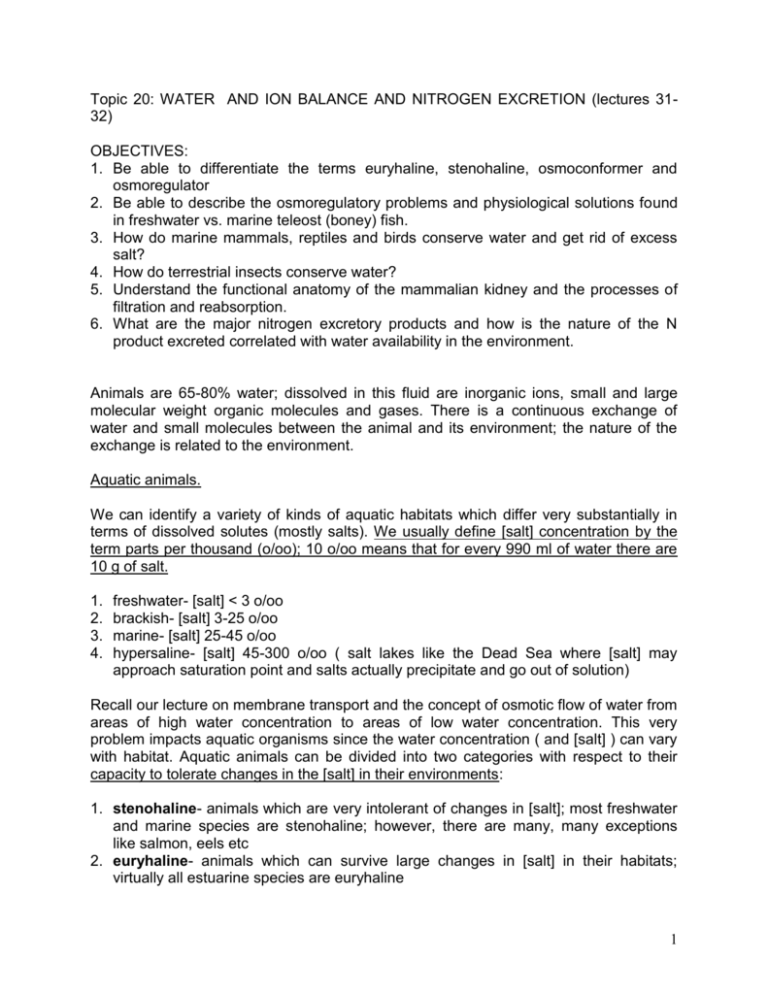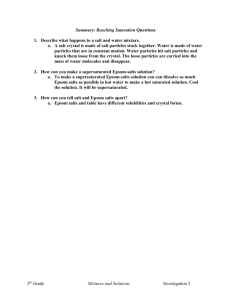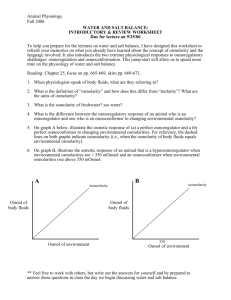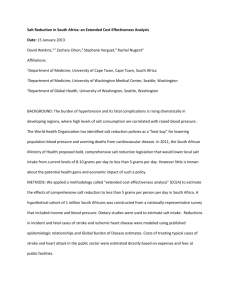Topic 19: WATER AND ION BALANCE AND NITROGEN EXCRETION
advertisement

Topic 20: WATER AND ION BALANCE AND NITROGEN EXCRETION (lectures 3132) OBJECTIVES: 1. Be able to differentiate the terms euryhaline, stenohaline, osmoconformer and osmoregulator 2. Be able to describe the osmoregulatory problems and physiological solutions found in freshwater vs. marine teleost (boney) fish. 3. How do marine mammals, reptiles and birds conserve water and get rid of excess salt? 4. How do terrestrial insects conserve water? 5. Understand the functional anatomy of the mammalian kidney and the processes of filtration and reabsorption. 6. What are the major nitrogen excretory products and how is the nature of the N product excreted correlated with water availability in the environment. Animals are 65-80% water; dissolved in this fluid are inorganic ions, small and large molecular weight organic molecules and gases. There is a continuous exchange of water and small molecules between the animal and its environment; the nature of the exchange is related to the environment. Aquatic animals. We can identify a variety of kinds of aquatic habitats which differ very substantially in terms of dissolved solutes (mostly salts). We usually define [salt] concentration by the term parts per thousand (o/oo); 10 o/oo means that for every 990 ml of water there are 10 g of salt. 1. 2. 3. 4. freshwater- [salt] < 3 o/oo brackish- [salt] 3-25 o/oo marine- [salt] 25-45 o/oo hypersaline- [salt] 45-300 o/oo ( salt lakes like the Dead Sea where [salt] may approach saturation point and salts actually precipitate and go out of solution) Recall our lecture on membrane transport and the concept of osmotic flow of water from areas of high water concentration to areas of low water concentration. This very problem impacts aquatic organisms since the water concentration ( and [salt] ) can vary with habitat. Aquatic animals can be divided into two categories with respect to their capacity to tolerate changes in the [salt] in their environments: 1. stenohaline- animals which are very intolerant of changes in [salt]; most freshwater and marine species are stenohaline; however, there are many, many exceptions like salmon, eels etc 2. euryhaline- animals which can survive large changes in [salt] in their habitats; virtually all estuarine species are euryhaline 1 Animals can also be characterized with respect to the relationship between the solute concentration of their body fluids and the [salt] in their habitats. Before we talk about this let me define another termOsmolarity- an index of the solute concentration in a solution; is directly proportional to the solute concentration thus the higher the osmolarity, the lower the water content Osm [salt]; Osm 1/[water] 1. osmoconformers- animals that have an internal osmolarity that is always equal to the external osmolarity. That is, when the external [salt] changes, the internal osmolarity passively adjust until it is equal to the external osmolarity; animals literally gain or lose water. Most marine invertebrates and cartilaginous fish (sharks, rays etc) are osmoconformers. 2. Osmoregulators- animals that maintain a constant internal osmolarity in spite of the fact that the external osmolarity may be different. In effect, these animals are in osmotic disequilibrium with their habitats- characteristic of all boney fish, aquatic amphibians, reptiles, birds & mammals and freshwater & hypersaline invertebrates. Fig. 44.14Marine teleost fish- are hypo-osmotic with respect to the habitat; lose water and gain salts. They compensate by drinking seawater and actively transporting excess salts out of the gills; also produce minimal urine. Freshwater teleost fish- are hyper-osmotic; gain water and lose salts; produce copious, dilute urine to get rid of excess water and conserve salts; actively transport salts from the water into the body through the gills (think of the problems that salmon face when they return to their ancestral spawning streams after spending years in the marine environment!!!) Marine mammals, reptiles and birds Are hypo-osmotic with respect to seawater so they face continuous influx of salt and efflux of body water. Two generalized adaptations: 1. drink large amounts of seawater 2. get rid of excess salts a. mammals- produce a very concentrated urine, low in volume, high in salt content b. marine reptiles- have salt secreting glands which dump very salty secretion into eyes (turtles), nose (marine iguanas) and mouth (sea snakes) c. birds- have salt secreting glands which empty into the nostril 2 Terrestrial animals. Water loss can be real problem in most terrestrial animals; it can occur by a variety of ways: 1. evaporation across body surface 2. respiratory water loss; when air is expired it is water saturated! 3. excretory water losses (urine, feces) Except for organisms living in moist, terrestrial habitats, the conservation of water is an important feature of the physiology of these creatures. As the habitat gets dryer, water conservation becomes even more critical as shown by the kangaroo rat vs. human comparison in fig. 44.16- rat does not have access to water! Some examples of water conservation mechanisms in terrestrial animals. Insects (fig. 44.20)- represent the most “successful” group of animals with as many as 5+ million species, many of which occupy very dry habitats. These animals have a common digestive and “urinary” tract consisting of Malphigian tubules which empty into the GI tract (fig. 44.20); the resulting materials pass into the intestine and then the rectum where as much as 98% of the water will be reabsorbed; the feces is essentially dry! Mammals- have what is known as the glomerular kidney; that is, a kidney each of which consists of several million filtration ( the glomerulus ) and water reabsorption structures called the nephron unit. Fig. 44.21- functional anatomy of the mammalian kidney What does the kidney do? 1. filters the blood- makes a cell-free, protein-free filtrate which has the same osmolarity as that of the blood the filtrate (=urine) is then modified by the kidney 2. secretes additional materials into the urine- substances like acids, bases, toxins etc are transferred from the blood into the urine 3. reabsorbs substances from the urine- water, salts, small molecular weight organic materials are transferred back into the blood The final urine is usually very concentrated in terms of solute (mostly urea and some salt) and has a low volume. We’ll talk about filtration and reabsorption in some detail. Filtration. 1. blood enters the glomerulus (a meshwork of capillaries) by way of the afferent arteriole 3 2. blood pressure in the capillaries forces water and low molecular wgt materials through a filtration device which excludes proteins and cells 3. materials that are filtered-water, salts, urea, small molecular wgt organics like glucose and amino acids Reabsorption. Fig. 44.221. the nephron unit is divided into distinct regions, each having somewhat specialized functions- proximal convoluted tubule, descending limb of the loop of Henle, thin segment of the ascending limb, thick segment of the ascending limb, distal convoluted tubule and collecting duct 2. proximal convoluted tubule- water and salt reabsorption 3. descending limb of the loop of Henle- water reabsorption 4. thin segment of the ascending limb and thick segment of the ascending limb- NaCl reabsorption 5. collecting duct- urea and water reabsorption The amount of water that is reabsorbed by the collecting duct, and hence the concentration of the urine, depends on how permeable the collecting duct membrane is to water. This permeability is under hormonal control. If the blood osmolarity rises, the brain triggers thirst and also releases a hormone called antidiuretic hormone which causes the walls of the collecting duct to become more permeable to water. The opposite takes place when blood osmolarity is too low. Nitrogen excretion and the environment. Ammonia is the ultimate end product of the catabolism of nitrogen-containing molecules. Ammonia cannot accumulate to very high concentrations because it is toxic. It is either directly excreted or converted into relatively non-toxic compounds. Fig. 44.131. most aquatic animals excrete ammonia directly into the environment 2. mammals and terrestrial amphibians produce urea which can be excreted at relatively high concentrations in urine 3. birds, insects, reptiles like lizards and terrestrial snail convert ammonia into uric acid; uric acid can be excreted with minimal water loss. In fact, uric acid forms crystals which can be excreted or actually accumulated in the body as takes place in some pulmonate (lunged) snails. 4










